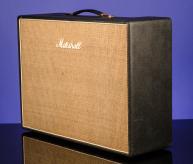"One of the Greatest Distortion Tones I've Ever Heard" Michael Doyle (Author of The History of Marshall)
1968 Marshall Model 1973 20W 2 x 12" 'Plexiglass' Combo Lead & Bass Model
This is a very rare, all original, 1968 20 watt Marshall Combo with two twelve inch speakers. This amplifier has just been fully serviced by Doug Anderson (Tone Zone, Altadena, CA) and is in perfect working order. The amplifier has not been converted to USA 115 voltage and comes with a "Tone Zone" step-up transformer for use in the USA. Very few of these Combo's have survived and this is certainly the best example that we have ever seen. We recently sold one of the 'legendary' 18 Watt Combo's - a 1967 "Model 1973 18W 2 x 12" 'Plexiglass' Combo Lead, Bass & Organ" and this 20 watt (one year later) model sounds quite similar.
Dimensions:
Width: 28 inches
Height: 20 inches (including rubber feet)
Depth: 9 inches
Weight: 56 lbs.
Specifications:
Tubes: Preamp - 2 x ECC83; Output - 2 x EL34; 1 x Solid State Rectifier
Speakers: 2 x Celestion G12 M 25W 16 ohms 'Greenbacks'
Speaker codes: T 1221 M3 HA & 11 FM
Inputs: Four
Controls: Standby switch; On/Off switch; Tremolo Speed: Tremolo intensity; Tone; Volume; Tone; Volume.
Grille Cloth: Brown Basket Weave
Cabinet covering: Black Vinyl
"From a commercial point of view the 20-watt amps were a far gretater success than their predecessors, and were in production from 1967 to 1973. Consequently there are a lot more of them around and they are very popular , especially in the head version. This is understandable, of course, because they look great, and some of them even have the Plexiglass control panels, "so they must be good"! While the first 20-watts were cosmetically identical to the 18-watts and even shared the same model numbers, electronically they bore little resemblence to the earlier amps. They used two ECC83 preamp valves, two EL84 output valves, the rectifier was solid-state instead of valve, and reverb was no longer an option." (Michael Doyle. The History of Marshall, p. 41).



















